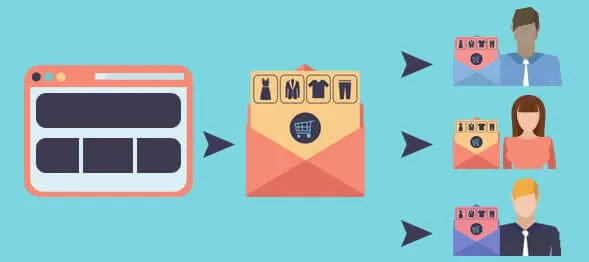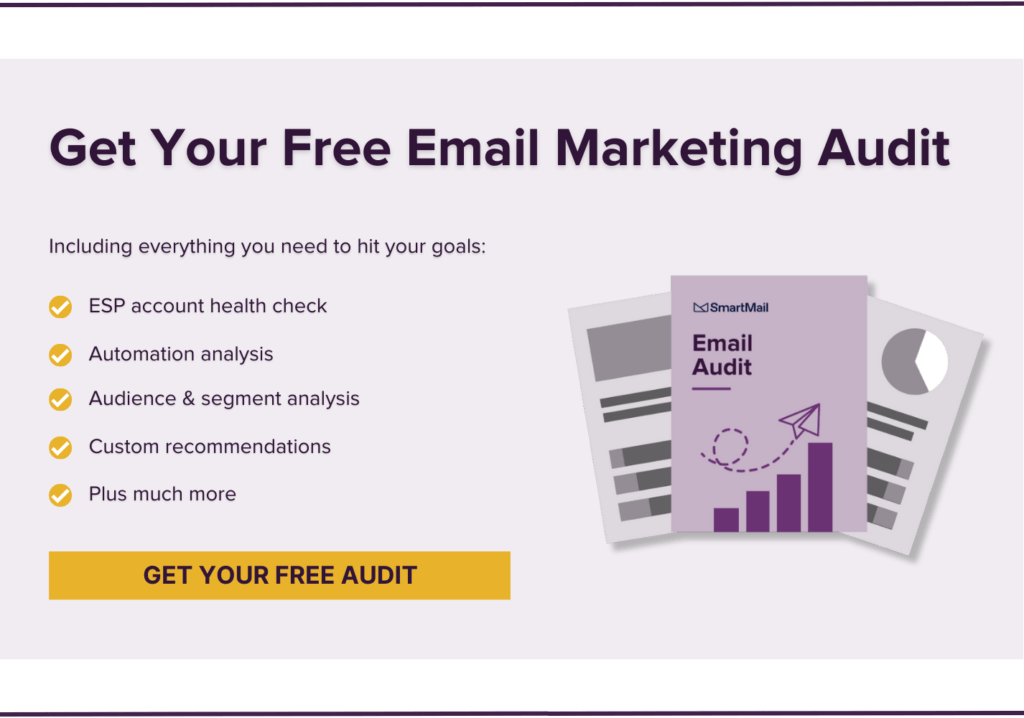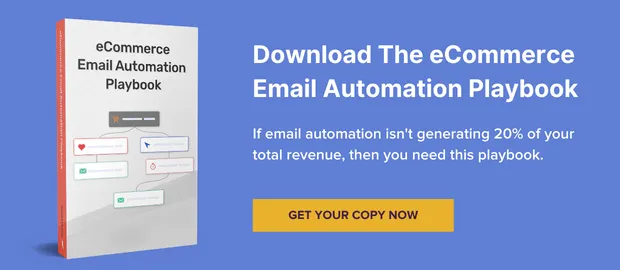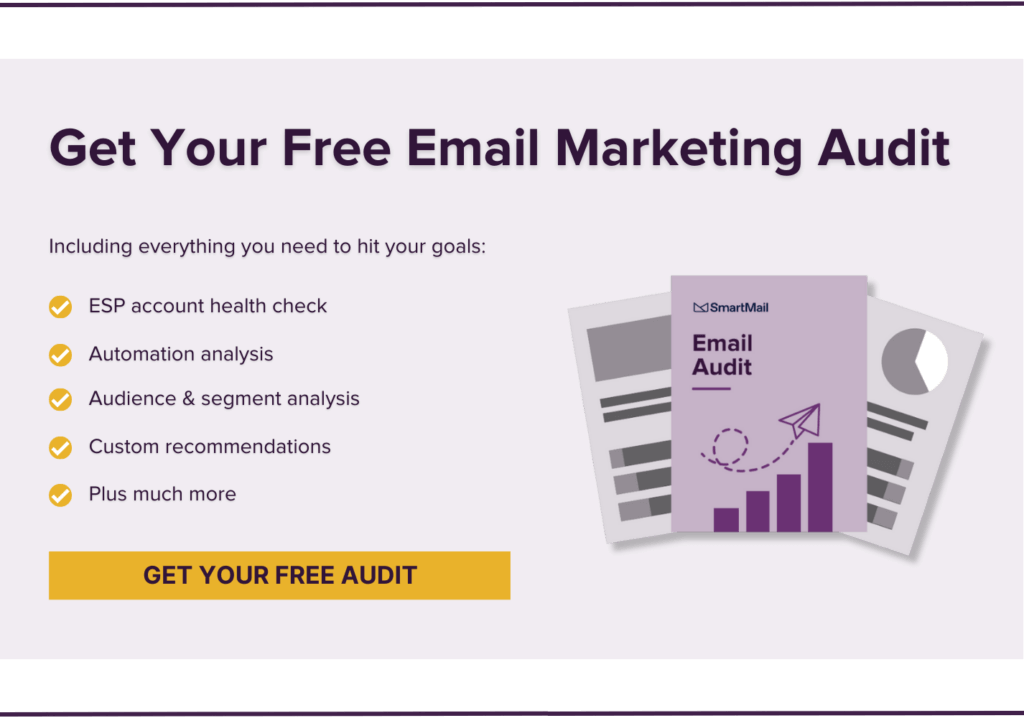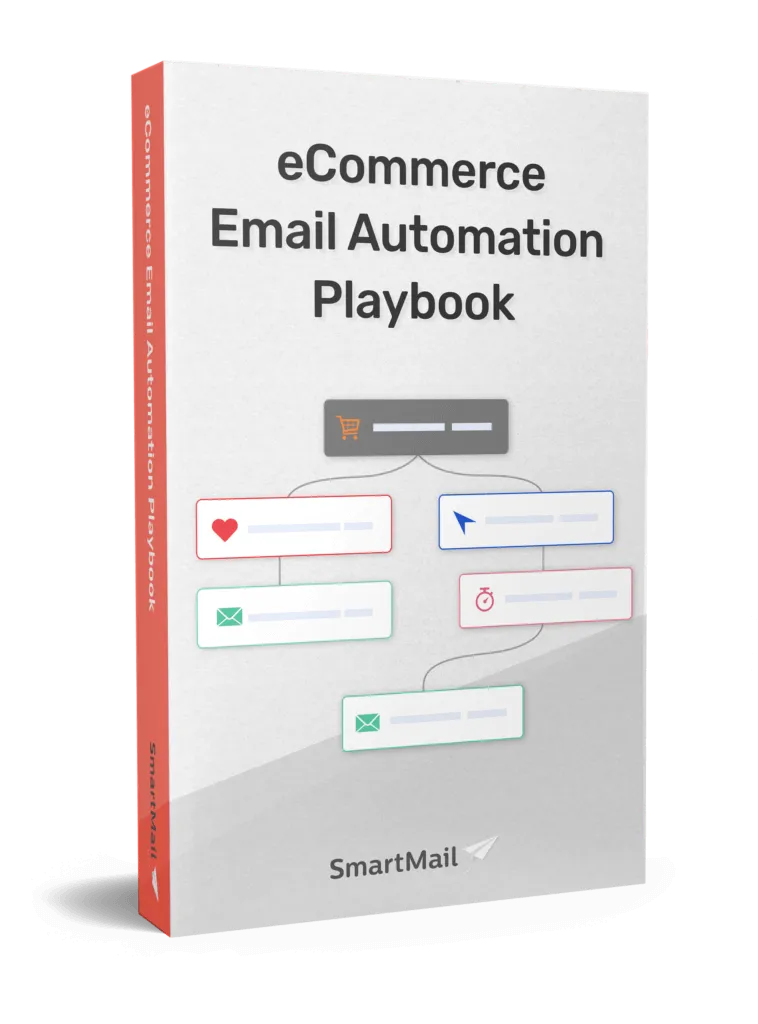Personalized Product Recommendations in email are a proven way to increase customer engagement, improve click through rates, and ultimately generate more online revenue. We created this guide to help eCommerce professionals implement better personalization strategies through email marketing.
In this guide, you’ll learn:
How product recommendations work and how to use them to generate more sales
The secret sauce to personalizing recommendations and email content for your shoppers
Proven strategies to increase CTR across key converting email campaigns
Advanced tips and tricks to personalizing the over-arching shopping experience for your customers
When Amazon, the holy grail of eCommerce, started displaying product recommendations for browsing shoppers back in early 2000, it revolutionized the way we shop.
Their basic, simplistic design and layout become secondary to the unprecedented personalized experience they created for shoppers by leveraging actual browser behavior data in real time. It’s reported that nearly one-third of Amazon’s revenue is generated by personalization efforts alone.
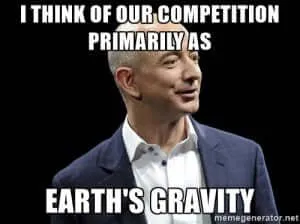
This trend of personalization has changed the way other eCommerce sites utilize data to drive customer engagement, and while Amazon may be tough competition for smaller to mid-sized businesses, intelligent product recommendations (as opposed to generic suggestions) are now a common online marketing fixture that shoppers have come to expect.
Product recommendations, when done right, can be so successful that they can successfully bring back past and abandoning shoppers. In fact, 56% of online shoppers report that they are more likely to return to sites that offer personalized product recommendations.
It’s no wonder that personalized product recommendations have also been shown to increase conversions by 150% and average order value by 50%!
If we are to learn anything from the incredible success of Amazon, it’s that you don’t need high end graphics or fancy design to generate more online sales. It’s data-driven personalization that can be the key to increasing revenue.
But if you’re not Amazon or a master of big data integration then you’re probably wondering what personalized product recommendation tools are out there for you.
Let’s break it down.
The Technology Gap Between On-Site and Off-Site Product Recommendations
On-site product recommendations have advanced tremendously since they first hit the scene, now utilizing sophisticated algorithms that allow merchants to utilize browser behavior data in real time to power personalized recommendations.
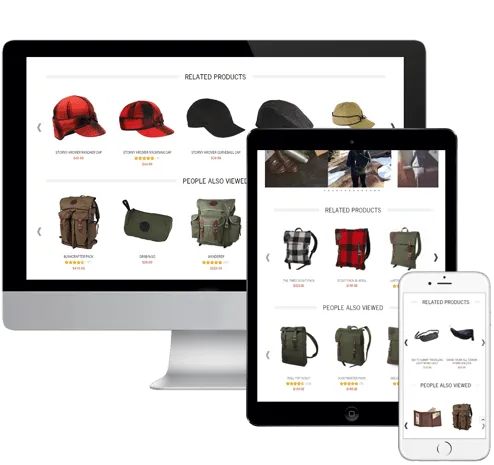
Unfortunately, the tech for taking this complex data and injecting it into the off-site shopping experience has seriously lagged behind, which is ironic since the highest converting off-site marketing channel tends to be email
Taking the power of email into account, it’s surprising that personalized product recommendation engines for email marketing are limited.
Most of the options currently on the market are either incredibly expensive, difficult to integrate, or lacking the capability to leverage complex user data in real time.
The complex email marketing solutions like Exact Target or Silverpop aim to mimic Amazon’s tactics but their integrations are complicated, can take forever to implement, and their services run on the expensive side.
The more commonly-known email software providers such as Mailchimp, AWeber, Bronto, and SendGrid and so-called eCommerce-focused platforms like Klaviyo and MailGet have come a long way in providing marketers with triggered events options and automation filters, yet they still come up short when it comes to leveraging actual user data in real time to generate relevant and varied personalized product recommendations.
This presents a difficult challenge for eCommerce marketing professionals who seek to create that personalized email experience for every single shopper on their site.
Frustrating, right?
Well, worry no more because you’ve come to the right place. We’re going to show you how you can personalize each email experience for every shopper on your site in a way that’s simple for you and effective for your business.
Keep reading…
Enjoying this content?
Join the other 5,473 eCommerce business owners.
Why Personalized Product Recommendations Work

When used intelligently, email is a great tool that can generate a significant amount of revenue and successfully recapture the traffic you nearly lost. To keep your email campaigns smart, you’ve got to be constantly improving the messages as much as possible.
The only way to really increase conversion and retention rates with email is by first looking at the two key metrics of email marketing success: open rate and click through rate.
Open rate is directly related to deliverability and subject line.
CTR is all about the content within the email. And this is where the magic happens.
If the content of your emails are relevant to shoppers, you’ll wind up with a great CTR. Include great, personalized content in your emails, and you’ll get shoppers clicking through your emails and back onto your site.
All of the traffic that abandoned your site suddenly comes rushing back.
Ask yourself, “Is this email message relevant to each individual shopper or is it generic and too broad? Do my emails match various user behavior segments or are they just a catch-all for all all site traffic?”
Sending a generic email to all shoppers just doesn’t cut it. So how can you use product recommendations to make your emails appealing and relevant to each individual shopper and, as a result, increase your click through rates?
Personalized Product Recommendations in Email Can Increase CTR by 300% or More
Higher CTR means higher chance of conversion and more lost traffic back on your site. The idea is that the more options – relevant, engaging, appealing options – you present to your shoppers in email, the more likely they are to click and voila! Your CTR is up.
Personalized product recommendations are a great way to make email content relevant, enticing, and clickable. This is why personalized product recommendations to the right shoppers can be the key to transforming your online business.
The Secret Sauce to Increasing Sales with Recommendations in Email
When using product recommendations in your email campaigns, it’s important to remember that the purpose of product recommendations is to engage with shoppers in a personalized way, NOT just to fill up space and hope something sticks.
To achieve real personalization with your product recommendations, use different algorithms for different campaigns. Each campaign targets a different user segment, displaying data-driven content that actually brings shoppers back.
(If this “different algorithm” stuff is throwing you off or making you wonder how you can implement personalized product recommendations, read on or contact us for help!)
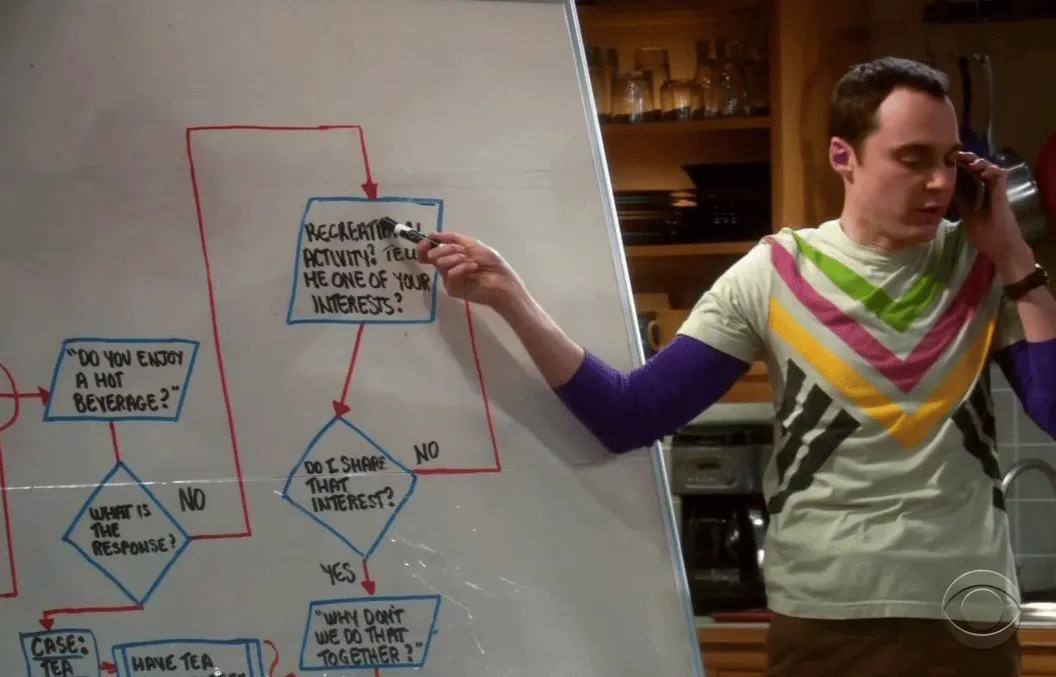
It may seem complex but it’s not totally rocket science. Let’s walk you through it…
Identify the user segments on your site (we recommend focusing on the 5 above), and then personalize the content for each individual user within the emails that are sent. For maximum impact, set your 5 abandonment campaigns, and within each campaign, using varied algorithms set for recommendation personalization, each email will be relevant to every single shopper on a one to one basis.
Keep reading or talk to us directly to discover how to implement proven strategies for using product recommendations in email.
Recommendations for Homepage Browsers
User Segment:Shoppers that browse your homepage but never make it any further into your site. Like window shoppers.
Product Recommendation Algorithm:Display a mix of site-wide best sellers and recent top sellers.
Here is an example of a Homepage Browse Abandonment email with personalized product recommendations:
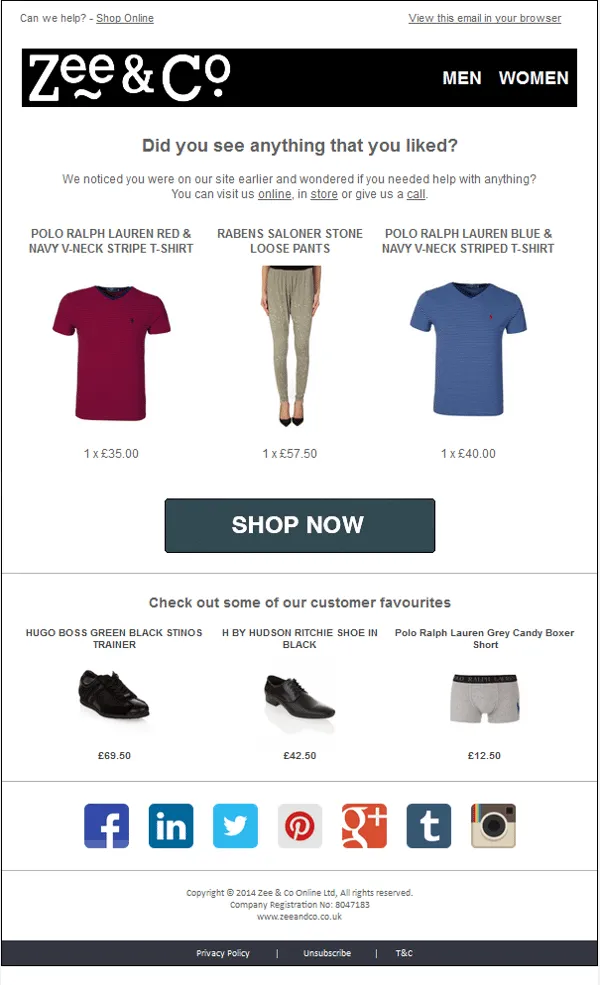
In this email, this retailer has done a great job prominently displaying various top sellers. We’d recommend that they use larger product images and perhaps fix the alignment of the product titles or remove them altogether for increased CTR.
Recommendations for Category Browsers
User Segment:These are the shoppers that click on and view a specific category, brand, or department but never actually view specific, individual products.
Product Recommendation Algorithm:Display product recommendations from the category the shopper was browsing, taking into account the best sellers within that category.
Here is an example of a Category Browse Abandonment email with personalized product recommendations:
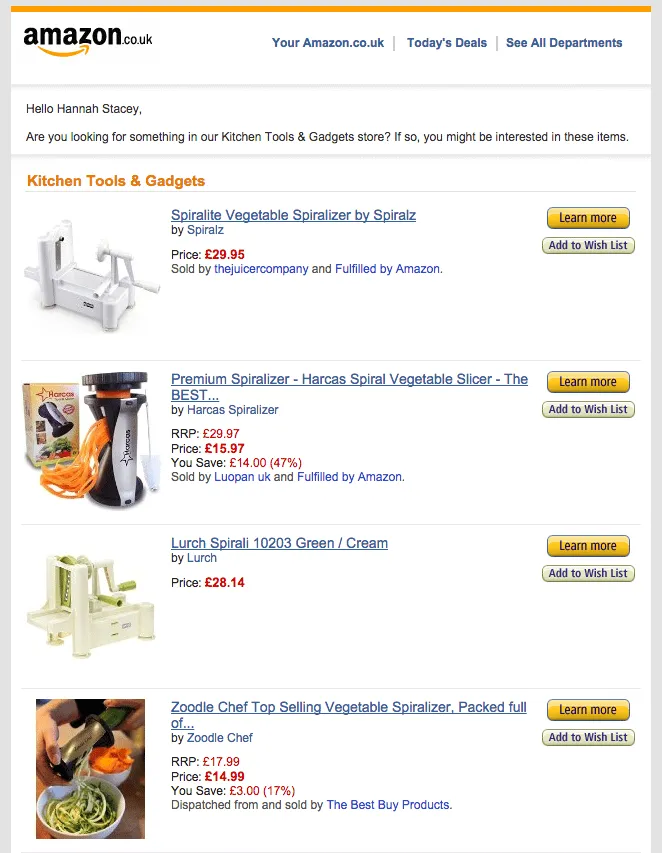
It’s no surprise that Amazon gets this right. What can we say? In this email, the recommendations ARE the entire email, which is great. It’s interesting to note that they use a soft call to action with buttons that say “Learn more” and “Add to Wish List” without pushing shoppers to directly “add to cart.”
Recommendations for Product Browsers
User Segment: These are shoppers who have viewed specific, individual products on your site but did not actually add any of those products to their carts.
Product Recommendation Algorithm: Display the exact product that the shopper viewed and then insert a mix of product-related best sellers and category-related best sellers as an upsell/downsell tactic.
This is an example of a Product Browse Abandonment email with personalized product recommendations:
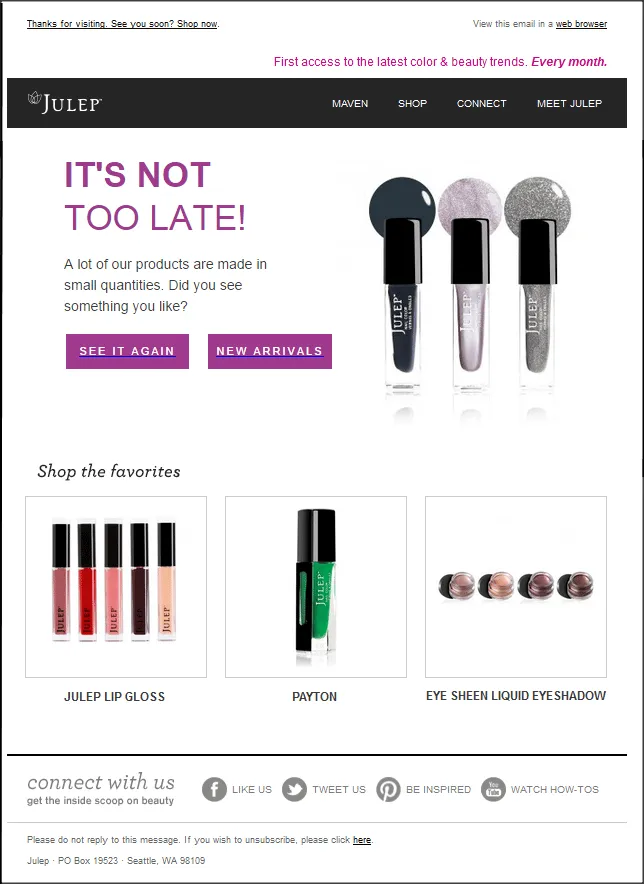
This retailer has done a great job using large, high quality images, nice display of titles without price, and creating a slight sense of urgency with the headline. Well done!
Recommendations for Site Search Browsers
User Segment: These shoppers have typed in a search term in your site search navigation yet did not go on to view any categories, products, or add anything to their carts.
Product Recommendation Algorithm: Display recommendations of top sellers within the category related to the search performed by the shopper.
Here is an example of a Site Search Abandonment email with personalized product recommendations:
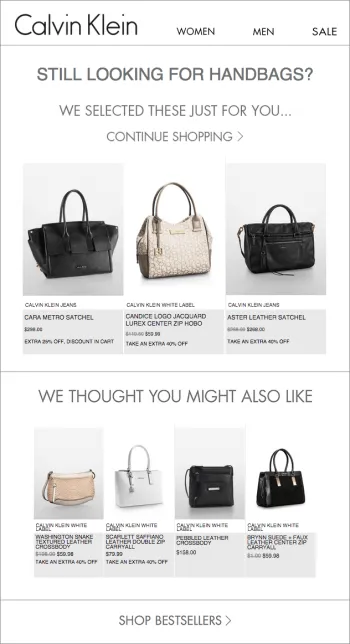
We like how this retailer uses different types of recommendations within one email that matches the searched term. They also use great imagery that’s varied and stands out. Only recommendation here would be to maybe cut back on the text under each product or display it a bit cleaner.
Recommendations for Cart Abandonment
User Segment: These are the shoppers who have gone so far as to actually add a product or products to their carts! This is only ever about 5% of site traffic, so if they’ve made it this far, it’s worth trying to get them back!
Product Recommendation Algorithm: Display the actual cart that the shopper left behind, fully populated with the products he added to his cart plus insert product and category-related best sellers as an upsell/downsell tactic.
This is an example of a Cart Abandonment email with personalized product recommendations:
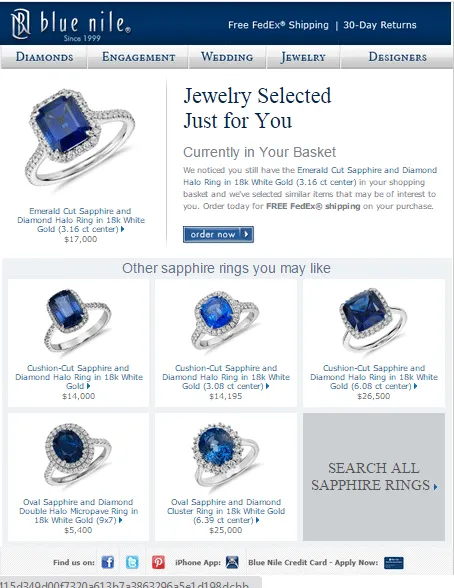
This is a nice use of personalized product recommendations within a cart abandonment email. Here, the retailer displays similar products to the one left behind in the cart, and what’s especially nice is that they display products at varying price points, which might possibly be a consideration that caused this shopper to abandon a populated cart.
Now that you know which product recommendations to use for each campaign, here is a checklist to make sure that your emails look and perform as good as they sound.
Fool-Proof Checklist for Product Recommendation Emails
Make sure product recommendations are responsive, mobile-friendly and optimized for on all devices.
If the recommendations for desktop viewing are displayed horizontally, make sure they render vertically for mobile, one on top of the other for greater visibility.
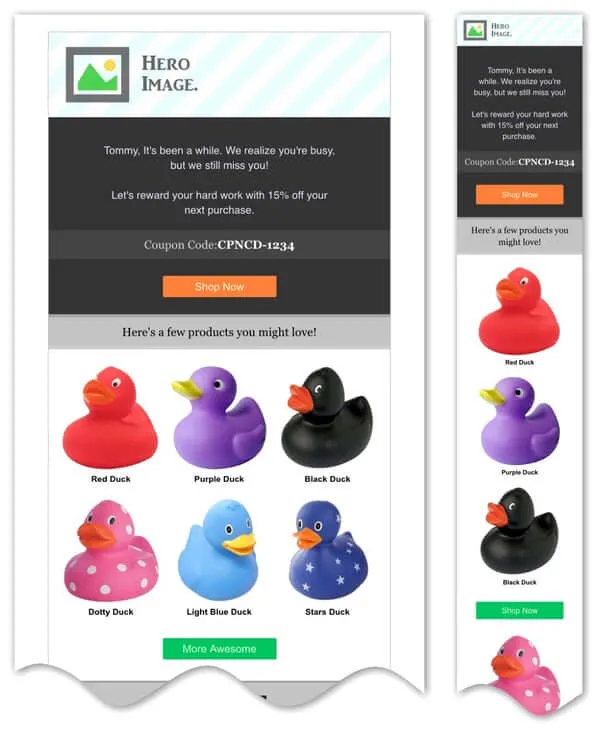
Use large, high quality images for each product to entice shoppers to view more.
Use a different algorithm for each user segment based on browser behavior, in real time to ensure that recommendations are relevant to your shoppers.
Use multiple recommendation algorithms inside one email for increased CTR (i.e. display a row of top sellers + a row of related products).
Make sure to send only one email to each shopper that matches the furthest point they reached in the shopping funnel. (i.e. A shopper views a category and then a specific product but then abandons. This shopper should only receive a product browse abandonment email, excluding him from homepage, category, and other behaviorally triggered email campaigns.)
Need help implementing these campaigns for your online store? Talk to us!
4 Advanced Tips and Tricks For Using Personalized Product Recommendations in Email
1. In product browse abandonment emails you can display three different types of recommendations to up your CTR. Display one row with product-related recommendations, a second row with category-related recommendations, and the last row with general site-wide top sellers.
2. Engage with shoppers using email sequences and vary the recommendations across the messages in your sequence. For cart abandonment emails, the first email should include closely-related recommendations that complement the abandoned items. In the second email in the sequence, broaden the recommendations slightly to peak the interest of shoppers who may be less interested in the specific products they abandoned but still open to shopping on your site. In the third email, keep the content the same but change up the recommendations to reflect recent top sellers.
3. When optimizing your emails for mobile, make sure your recommendations are responsive. If your desktop design displays 3 products in one row, your mobile design should stack each product on top of the next rather than simply shrinking rows down. This allows the product imagery to stand out and therefore elicit clicks.
4. Maintain intrigue and peak shoppers’ interests when displaying products by hiding the price and displaying large product images. This can increase CTR because it gets shoppers wondering and therefore clicking back to your site. When tested, CTR was improved by 37% in some cases by simply removing the price and in other cases removing the title.
Personalized Campaigns with Product Recommendations Outperform Every Other Marketing Channel
Example #1: CTR increase with personalized product recommendations

Here, this merchant’s product browse abandonment emails started off with a 17% click through rate when they displayed no product recommendations. As we added personalized recommendations to the email content, the CTR went up to 29%.
Example #2: Increased revenue with emails displaying personalized product recommendations

In this case, this merchant’s email containing personalized recommendations clearly outperformed the emails that did not contain recommendations at all. The email containing 12 personalized recommendations generated the most revenue.
Be Like Amazon With Intelligent Shopper Engagement Via Email
Personalized product recommendations are an excellent way to personalize each email experience for every individual shopper on your site. Now that we’ve demystified the process to implementing personalized product recommendations, you can make like Amazon and engage with your shoppers more effectively in email.
Need more help implementing personalized product recommendations for your email marketing campaigns? Click here to learn how SmartMail can help you implement a winning email marketing strategy and increase conversions, average order value, and overall site revenue.
